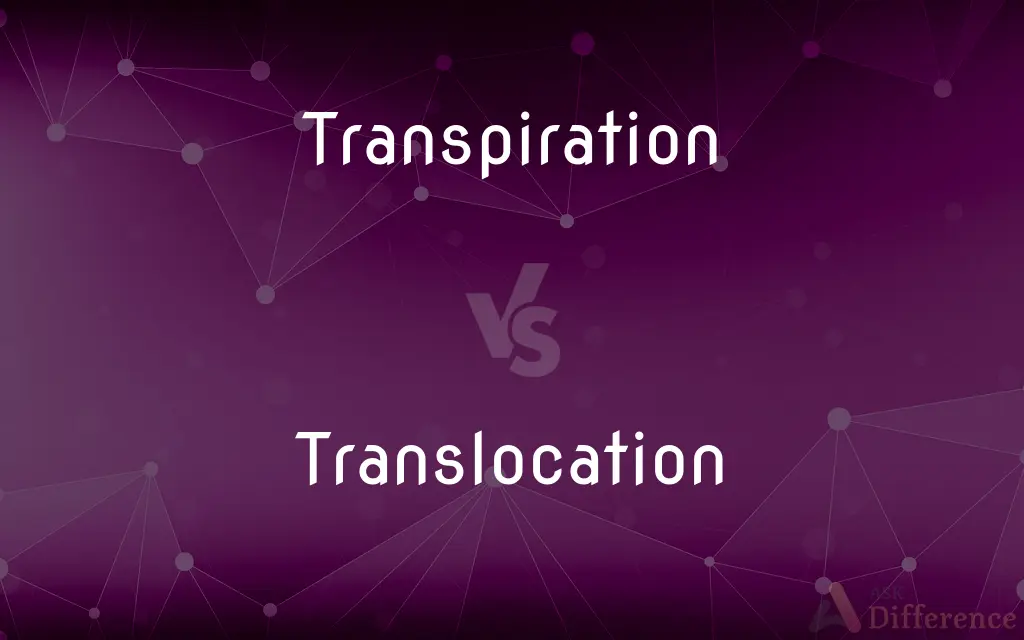Transpiration vs. Translocation — What's the Difference?
By Urooj Arif & Fiza Rafique — Updated on March 30, 2024
Transpiration involves water movement through plants and its evaporation from aerial parts, while translocation is the transport of nutrients within plants.

Difference Between Transpiration and Translocation
Table of Contents
ADVERTISEMENT
Key Differences
Transpiration is a physiological process where water is absorbed by plant roots, moves through the plant's vascular system, and is eventually released into the atmosphere as water vapor through stomata in the leaves. On the other hand, translocation refers to the movement of nutrients and sugars produced in the leaves (via photosynthesis) throughout the plant.
Transpiration is driven by factors such as temperature, humidity, wind, and soil water availability, which affect the rate at which plants lose water to the atmosphere. Conversely, translocation is influenced by the plant's need for nutrients in different parts, which can vary based on growth stages, environmental conditions, and overall health of the plant. The movement of sugars and other solutes in translocation is an energy-dependent process, requiring active transport mechanisms to distribute these compounds against concentration gradients.
While both processes involve the movement of substances through the plant's vascular system, transpiration primarily involves the xylem vessels for water transport from the roots to the leaves. In contrast, translocation occurs in the phloem, transporting organic nutrients and sugars from the sites of production (like leaves) to where they are needed or stored. This fundamental difference underscores the roles each process plays in plant physiology: transpiration in water balance and cooling, and translocation in nutrient distribution and energy supply.
The significance of transpiration extends beyond individual plants, impacting the hydrological cycle and local and global climates. Transpiration contributes to the formation of rain clouds and can affect temperature and humidity levels in an area. Meanwhile, translocation is crucial for the growth and development of plants, ensuring that energy produced through photosynthesis is available to support various functions, from growth and flowering to fruit development and root expansion.
Despite their differences, both transpiration and translocation are integral to plant health and survival. Transpiration helps in nutrient uptake and temperature regulation, while translocation ensures the distribution of energy and nutrients necessary for growth and reproduction. Understanding these processes is essential for agricultural practices, environmental management, and the study of plant biology.
ADVERTISEMENT
Comparison Chart
Process
Movement and evaporation of water from plants
Transport of nutrients and sugars within plants
Involved Tissues
Xylem
Phloem
Main Function
Regulates water balance, aids in cooling
Distributes nutrients and energy throughout the plant
Driving Factors
Temperature, humidity, wind, soil water availability
Plant's nutrient needs, growth stages, environmental conditions
Impact
Influences hydrological cycle, local and global climate
Essential for plant growth, development, and reproduction
Compare with Definitions
Transpiration
Water Movement.
Water moves from the roots to the leaves, where it evaporates into the atmosphere.
Translocation
Seasonal Adjustments.
Translocation patterns can change with the plant's developmental stage and environmental conditions.
Transpiration
Cooling Mechanism.
Evaporation of water from leaves cools the plant on hot days.
Translocation
Nutrient Transport.
Sugars produced in the leaves are distributed throughout the plant via phloem.
Transpiration
Environmental Influence.
High temperatures can increase the rate of transpiration in plants.
Translocation
Energy Distribution.
Energy stored in sugars is transported to growing and storage tissues.
Transpiration
Hydrological Cycle Contribution.
Transpiration contributes to cloud formation and local humidity levels.
Translocation
Growth Support.
Translocation supplies nutrients essential for flowering and fruit development.
Transpiration
Stomata Role.
Stomata on leaf surfaces open to allow water vapor to exit, driving transpiration.
Translocation
Active Transport.
Nutrients move against concentration gradients, requiring energy.
Transpiration
Transpiration is the process of water movement through a plant and its evaporation from aerial parts, such as leaves, stems and flowers. Water is necessary for plants but only a small amount of water taken up by the roots is used for growth and metabolism.
Translocation
A change of location.
Transpiration
The act or process of transpiring, especially through the stomata of plant tissue or the pores of the skin.
Translocation
A transfer of a chromosomal segment to a new position, especially on a nonhomologous chromosome.
Transpiration
(botany) The loss of water by evaporation in terrestrial plants, especially through the stomata; accompanied by a corresponding uptake from the roots.
Translocation
A chromosomal segment that is translocated.
Transpiration
(physiology) The process of giving off water vapour through the skin or mucous membranes.
Translocation
(Botany) The movement of sap downward and upward within the phloem, bringing nutrients to all living parts of a plant.
Transpiration
The passage of gases through fine tubes.
Translocation
Removal of things from one place to another; displacement; substitution of one thing for another.
Transpiration
The act or process of transpiring or excreting in the form of vapor; exhalation, as through the skin or other membranes of the body; as, pulmonary transpiration, or the excretion of aqueous vapor from the lungs. Perspiration is a form of transpiration.
Translocation
(genetics) A transfer of a chromosomal segment to a new position, especially on a nonhomologous chromosome; the segment so transferred.
Transpiration
The evaporation of water, or exhalation of aqueous vapor, from cells and masses of tissue.
Translocation
(biochemistry) A transfer of a molecule through a membrane.
Transpiration
The passing of gases through fine tubes, porous substances, or the like; as, transpiration through membranes.
Translocation
Removal of things from one place to another; substitution of one thing for another.
There happened certain translocations at the deluge.
Transpiration
The passage of gases through fine tubes because of differences in pressure or temperature
Translocation
The transport of dissolved material within a plant
Transpiration
The process of givng off or exhaling water vapor through the skin or mucous membranes
Translocation
(genetics) an exchange of chromosome parts;
Translocations can result in serious congenital disorders
Transpiration
The emission of water vapor from the leaves of plants
Common Curiosities
Why is transpiration important for plants?
It regulates water balance, aids in cooling, and contributes to nutrient uptake through the roots.
Can transpiration affect the environment?
Yes, it influences the hydrological cycle, affecting cloud formation and local climate conditions.
What is transpiration in plants?
Transpiration is the process of water movement through plants and its evaporation from aerial parts like leaves, stems, and flowers.
How do plants control transpiration?
Through the opening and closing of stomata, plants can regulate water loss according to environmental conditions.
Do all plants transpire and translocate?
Yes, all vascular plants perform both processes, essential for their growth and survival.
What factors affect the rate of translocation?
Nutrient needs, growth stages, and environmental conditions can influence translocation rates.
How does translocation benefit fruit production?
It transports sugars to fruits, enhancing their growth, sweetness, and nutritional value.
How does translocation differ from transpiration?
Translocation is the movement of nutrients and sugars within plants, unlike transpiration, which involves water.
What role does the phloem play in translocation?
Phloem is essential for transporting organic nutrients and sugars from leaves to other plant parts.
How are transpiration and translocation measured?
Transpiration can be measured using potometers or lysimeters, while translocation studies often use tracer elements.
What impact does translocation have on plant health?
It ensures that all parts of the plant receive necessary nutrients and energy for optimal growth and development.
Is transpiration more active during the day or night?
Transpiration is generally more active during the day when temperatures are higher and stomata are open.
How do these processes contribute to ecosystem health?
They play vital roles in water and nutrient cycling, supporting ecosystem diversity and productivity.
Can environmental stress affect translocation?
Yes, stresses like drought or nutrient deficiency can disrupt nutrient distribution within the plant.
What technologies are used to study these processes?
Technologies include remote sensing for transpiration and radioactive isotopes for studying translocation pathways.
Share Your Discovery

Previous Comparison
Indemnity vs. Indemnification
Next Comparison
Multiplexer vs. DecoderAuthor Spotlight
Written by
Urooj ArifUrooj is a skilled content writer at Ask Difference, known for her exceptional ability to simplify complex topics into engaging and informative content. With a passion for research and a flair for clear, concise writing, she consistently delivers articles that resonate with our diverse audience.
Co-written by
Fiza RafiqueFiza Rafique is a skilled content writer at AskDifference.com, where she meticulously refines and enhances written pieces. Drawing from her vast editorial expertise, Fiza ensures clarity, accuracy, and precision in every article. Passionate about language, she continually seeks to elevate the quality of content for readers worldwide.
















































